Restablecer tu contraseña de WordPress suele ser un proceso sencillo. Sin embargo, a veces los métodos estándar no funcionan, dejándote fuera de tu sitio web.
Algunos de nuestros lectores se han encontrado con este problema y nos han pedido consejo sobre la mejor manera de acceder a sus cuentas. Afortunadamente, siempre puedes usar la herramienta phpMyAdmin en el panel de control de tu cuenta de hosting para restablecer directamente tu contraseña desde la base de datos de WordPress.
En este artículo, te mostraremos cómo restablecer fácilmente una contraseña de WordPress desde phpMyAdmin. Explicaremos cada paso claramente, asegurando que incluso si no estás familiarizado con las bases de datos, puedas seguirlo de forma segura.
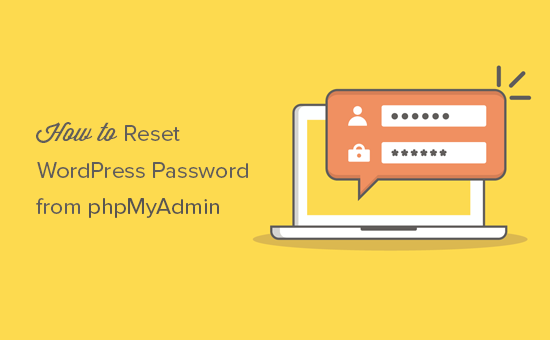
¿Por qué restablecer una contraseña de WordPress desde phpMyAdmin?
WordPress hace que sea muy fácil recuperar una contraseña perdida.
Simplemente puedes ir a la pantalla de inicio de sesión de tu sitio web de WordPress y hacer clic en el enlace '¿Olvidaste tu contraseña?'.
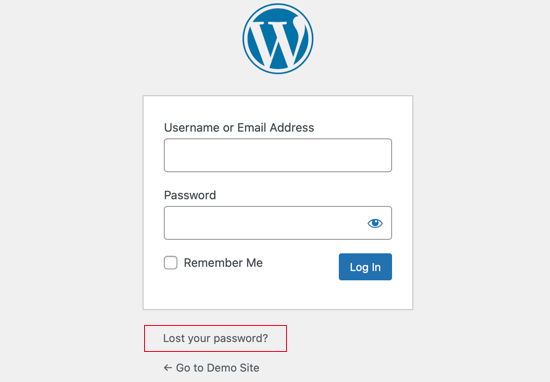
Al hacer clic en el enlace, serás dirigido a la página de restablecimiento de contraseña. Una vez que ingreses tu nombre de usuario o dirección de correo electrónico, WordPress enviará un enlace de restablecimiento de contraseña a la dirección de correo electrónico asociada.
Sin embargo, si no tienes acceso a esa dirección de correo electrónico, o tu sitio de WordPress no envía correos electrónicos, entonces no podrás restablecer tu contraseña.
En tal situación, necesitarás restablecer tu contraseña de WordPress directamente en la base de datos. La forma más fácil de hacerlo es usando phpMyAdmin.
Dicho esto, veamos cómo puedes restablecer fácilmente una contraseña de WordPress desde phpMyAdmin.
Cómo restablecer una contraseña de WordPress desde phpMyAdmin
Si no quieres ver el tutorial en video, puedes seguir leyendo la versión en texto a continuación.
Primero, necesitas iniciar sesión en el panel de control de cPanel de tu cuenta de hosting de WordPress. Luego, necesitas navegar a la sección Bases de datos, donde puedes hacer clic en el ícono de phpMyAdmin.
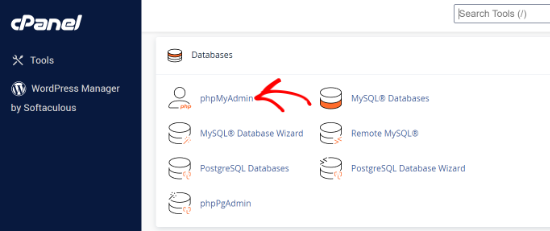
Esto iniciará la aplicación phpMyAdmin.
Aquí necesitas seleccionar tu base de datos de WordPress en el panel izquierdo.
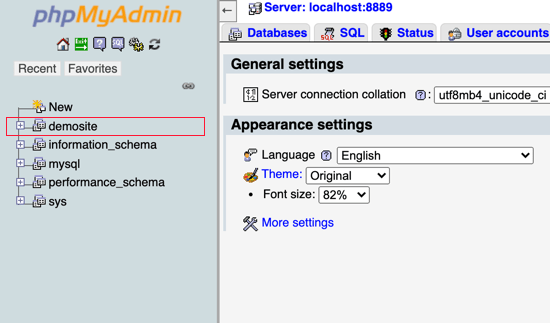
Ahora verás la lista de tablas en tu base de datos de WordPress.
Necesitas buscar la tabla wp_users en esta lista y hacer clic en el enlace ‘Browse’ (Explorar) junto a ella.
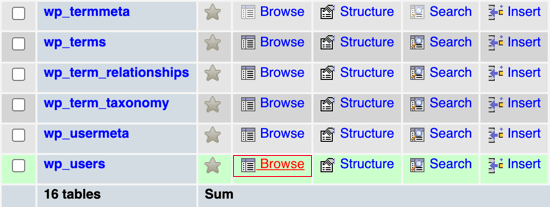
Nota: Los nombres de las tablas en tu base de datos de WordPress pueden tener un prefijo diferente al que mostramos en nuestra captura de pantalla. Cambiar los prefijos de tabla puede mejorar la seguridad de tu sitio de WordPress.
Ahora verás las filas en tu tabla de usuarios de WordPress. Continúa y haz clic en el botón de editar junto al nombre de usuario cuya contraseña deseas cambiar.
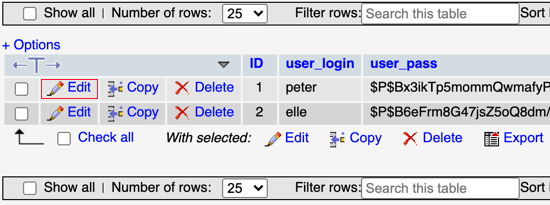
PhpMyAdmin te mostrará un formulario con todos los campos de información del usuario.
Deberás eliminar el valor en el campo user_pass y reemplazarlo con tu nueva contraseña. En la columna de función, selecciona MD5 del menú desplegable y luego haz clic en el botón Ir en la parte inferior del formulario.
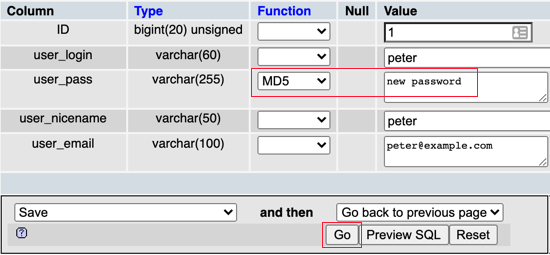
Tu contraseña se cifrará usando el hash MD5 y luego se almacenará en la base de datos.
¡Felicidades! Has cambiado exitosamente tu contraseña de WordPress usando phpMyAdmin.
Algunos de ustedes se preguntarán por qué seleccionamos el hash MD5 para cifrar la contraseña. WordPress usaba anteriormente el hash MD5 para cifrar contraseñas, pero desde WordPress 2.5 ha estado utilizando tecnologías de cifrado más sólidas.
Sin embargo, WordPress todavía reconoce MD5 para proporcionar compatibilidad con versiones anteriores. Tan pronto como inicies sesión usando una cadena de contraseña almacenada como un hash MD5, WordPress la cambiará automáticamente para usar los algoritmos de cifrado más nuevos.
Guías Expertas sobre Contraseñas en WordPress
Ahora que sabes cómo restablecer una contraseña de WordPress desde phpMyAdmin, es posible que desees ver otros artículos relacionados con contraseñas en WordPress.
- Cómo cambiar tu contraseña en WordPress (Guía para principiantes)
- Cómo restablecer contraseñas para todos los usuarios en WordPress
- Cómo Personalizar la Página de Restablecimiento de Contraseña de WordPress
- Cómo forzar a los usuarios a cambiar contraseñas en WordPress – Expire Password
- ¿Olvidaste tu contraseña? Cómo recuperar una contraseña perdida en WordPress
- Cómo forzar contraseñas seguras a los usuarios en WordPress
- Cómo agregar autenticación de dos factores en WordPress (método gratuito)
- Cómo Permitir a los Usuarios Ocultar/Mostrar Contraseñas en la Pantalla de Inicio de Sesión de WordPress
- Cómo administrar contraseñas de forma fácil y segura (Guía para principiantes)
Esperamos que este tutorial te haya ayudado a aprender cómo restablecer una contraseña de WordPress desde phpMyAdmin. También te puede interesar ver nuestra guía definitiva de seguridad de WordPress para mantener tu sitio seguro o nuestra selección experta de plugins imprescindibles.
Si te gustó este artículo, suscríbete a nuestro canal de YouTube para obtener tutoriales en video de WordPress. También puedes encontrarnos en Twitter y Facebook.





Graham
¡¡GRACIAS!!
Estaba atascado con el cifrado md5 del campo pw. Esto realmente me salvó. Estaba usando una actualización de perfil de miembro que eliminó todos los campos de correo electrónico. Esto a su vez también eliminó el mío y ¡puf! ¡Las contraseñas de todos fueron eliminadas.
En serio.
Así que, muchas gracias.
-Graham
Karen Seet
¿Cómo encuentro mi “proveedor de hosting” para poder acceder a phpmyadmin? Soy nuevo en esto.
Muhammad Talha
¡Muchas gracias!
Edwin Calimlim
Gran publicación, no pude acceder a mi sitio de WP durante meses, pero gracias a esta publicación, es de gran ayuda para mí. Gracias.
atif shahab
Thanks alot. I was worried and stuck as well as i was unable to acess my WordPress dashboard for 2 hours. your recipe worked quickly. Thanks once again
Soporte de WPBeginner
Glad it helped you solve the issue
Administrador
Niculina
¡¡Gracias!! ¡¡Funcionó!! :):)
Joel
¡Me salvaste la vida, gracias!
alan
Qué correo electrónico tan fantástico, soy nuevo en C-panel pero este tutorial fue tan claro que lo hice a la primera.
Buen trabajo.
Saludos,
Alan
Trevor
¡¡¡Gracias!!!
Pedro
Hice esto y ahora Jetpack me da este error:
Jetpack no pudo contactar a WordPress.com: register_http_request_failed. Esto generalmente significa que algo está configurado incorrectamente en su host web.
La operación expiró después de 15000 milisegundos con 0 bytes recibidos
¿Algún consejo sobre esto?
Margie
Thank you so much. The instructions were easy enough for even me to follow
Carina
Ojalá hubiera funcionado para mí... Seguí las instrucciones [fáciles] pero cuando fui a poner los números hash MD5, eran exactamente los mismos que ya estaban en el valor del campo. Esto me dice que mi problema no es al ingresar mi nombre de usuario y contraseña, sino algo completamente diferente... :(
Thom Burlington
Gracias, pero...
mientras ahora puedo restablecer la contraseña con el código MD5, derivado de la nueva contraseña que creé, digamos, “abc”, y termino y vuelvo al inicio de sesión de administrador de WordPress:
domain.org/wp-admin : nombre de usuario ; contraseña
para la contraseña, ¿ahora uso “abc”?
Thom Burlington
Sí, la contraseña es “abc” – muy bien – entre tu publicación y el video eres muy claro, gracias.
Neal Kelshaw
No es del todo correcto. Si eliges MD5 como la función en el menú desplegable, y luego escribes la contraseña en texto plano, se genera un valor MD5.
tobi
excelente publicación, muchas gracias
Jon O
¡Solo quería dar un GRAN agradecimiento por este artículo! De hecho, fui hackeado y busqué ayuda de mi empresa de hosting y otros... ¡pero este artículo fue el único enfoque directo que funcionó a la primera! ¡Muchas gracias!
Soporte de WPBeginner
Glad you found it helpful.
Administrador
Tanya
Pasé horas tratando de encontrar un sitio web que explicara por qué inicié sesión en mi WP y luego, 5 minutos después, no podía iniciar sesión de nuevo.
¡Muchas gracias por el video sencillo. Problema resuelto en 5 minutos!
¡Eres genial!
Soporte de WPBeginner
Me alegra que te haya resultado útil.
Administrador
Creina
Gracias. Para cualquiera que encuentre confuso el video, solo siga las instrucciones escritas.
ashish
muchas gracias por este tutorial…
Dairick
Gracias por este tutorial
Parbat Devkota
gracias, funciona de maravilla.
Alexandra Jones
Soy el tonto de Marte que no sabe hablar computadora. Empezaré con esto:
“El mejor lugar para buscar es tu archivo wp-config.php, que se encuentra en tu directorio raíz de WordPress.”
OK, ¿dónde está y cómo llego ahí? No puedo iniciar sesión en mi sitio porque no acepta ningún restablecimiento de contraseña. Intenté el método del teléfono de Chris y entré en mi teléfono, pero no en mi laptop. y cuando intenté publicar algo en el teléfono, recibí un mensaje de que debía instalar la última versión de Jetpack, pero tuve que iniciar sesión en WordPress de nuevo, y ¿adivina qué? – “Nombre de usuario no válido”.
¿Alguno de ustedes que encontró estas instrucciones tan sencillas está dispuesto a hablar conmigo por teléfono? Les escribo desde el final de mi ingenio. Ahí es donde estoy. ¡Lo agradecería mucho! ¡Saludos!
Soporte de WPBeginner
El archivo wp-config.php reside en tu servidor web. Puedes iniciar sesión en tu panel de control de alojamiento web, localizar el administrador de archivos y luego localizar el archivo wp-config.php. Alternativamente, también puedes editarlo usando un cliente FTP.
Administrador
Zania
¡Gracias! ¡Gracias! ¡Fácil y funcionó a la perfección!
chrismj06
Me salvaste la vida. ¡Bendiciones!
Jill
¡Gracias, eres un salvavidas y esto fue fácil de seguir!
Kristen
¡Salvaste el día! ¡Gracias!
AMIT KUMAR
¡Gracias! Simplemente estaba intentando ingresar la contraseña. Nunca supe del concepto MD5. Gracias de nuevo por un gran tutorial.
Silviu
Thank you
Dubb
Impresionante... ¡me salvaste el día una vez más, amigo!
Nigel
Impresionante, gracias.
Skye
¡¡¡¡¡¡GRACIAS!!!!! ¡Gran artículo!
Kumar
¡Funciona de maravilla!
hendriyana
¡¡¡Gracias!!! Genial... ayudó con mi problema....
Jaykesh
Increíble, gracias por la rápida ayuda.
luis
Muchas gracias, entré a php admin y copié y pegué la contraseña md5 y ya estoy dentro... ¡¡¡buen trabajo!
Muniyappa
Muchas gracias..
Tony Garcia
El desarrollador de un cliente falleció mientras estaba de vacaciones, de todas las cosas. Solo puedes imaginar lo que sucedió después. Nadie sabía nada de cómo su desarrollador estaba haciendo las cosas. Por suerte, pude localizar dónde estaban sus bases de datos y obtuve acceso a su PHPMyAdmin.
¡¡¡Voilá!!! Tengo ambos sitios perdidos de vuelta en funcionamiento con acceso a los back-ends gracias a esta publicación.
¡¡¡Gracias!!!
Carol Long
¡Gracias! ¡Me salvaste la vida!
Lori
Esto me ahorró un tiempo INTERMINABLE. No soy un novato en tecnología, pero sí en codificación. Estas instrucciones paso a paso me ayudaron a recuperar el acceso a mi sitio. Después de perder el acceso debido a un error de "corrección automática". (larga historia)
¡Gracias de nuevo!
christian gibson
¿Dices que Wordpress genera una encriptación MD5 de tu contraseña? Pero recuerdo haber visto en algún lugar de Stackoverflow que esto ya no es cierto. Dijeron: “El hasheador de contraseñas de WordPress implementa el framework portátil de hasheo de contraseñas de PHP, que se utiliza en sistemas de gestión de contenido como WordPress y Drupal”.
Sé muy poco sobre sistemas de encriptación/desencriptación, pero una cosa sí me parece extraña. En la base de datos de un sitio web de Wordpress, puedes ver en la tabla de usuarios un campo llamado ‘user-pass’ con contenidos como ‘$P$BlBAsz6jcvS3rLGDiE81PwtwbEazKg1’.
Todos los valores hash en esta tabla comienzan con $P$B….. así que, ¿cuál es el propósito de incluir estos 4 caracteres iniciales si todos son iguales……?
Samson
Muchas gracias. Me ahorraste tiempo valioso
Rod Salm
Como siempre, tutoriales directos y muy útiles. Van al grano y son sumamente precisos. Me gusta este consejo de phpadmin para las contraseñas.
¡Gracias!
Ben Glancy
O, si tu cuenta de administrador es la ID habitual = 1.
Abre functions.php y pon este código en
wp_set_password( "mypassword", 1 );
Recarga la página.
Descomenta el código. Hecho.
Diana
¡¡¡¡¡¡¡¡¡¡¡¡¡¡¡¡¡¡¡¡¡¡¡¡¡¡¡¡¡¡¡¡¡¡¡¡¡¡¡¡¡¡¡¡¡¡¡¡¡¡¡¡¡¡¡¡¡¡¡¡¡¡¡¡¡¡¡¡¡¡¡¡¡¡¡¡¡¡¡¡¡¡¡¡¡¡¡¡¡¡¡¡¡¡¡¡¡¡¡¡¡¡¡¡¡¡¡¡¡¡¡¡¡¡¡¡¡¡¡¡¡¡¡¡¡¡¡¡¡¡¡¡¡¡¡¡¡¡¡¡¡¡¡¡¡¡¡¡¡¡¡¡¡¡¡¡¡¡¡¡¡¡¡¡¡¡¡¡¡¡¡¡¡¡¡¡¡¡¡¡¡¡¡¡¡¡¡¡¡¡¡¡¡¡¡¡¡¡¡¡¡¡¡¡¡¡¡¡¡¡¡¡¡¡¡¡¡¡¡¡¡¡¡¡¡¡¡¡¡¡¡¡¡¡¡¡¡¡¡¡¡¡¡¡¡¡¡¡¡¡¡¡¡¡¡¡¡¡¡¡¡¡¡¡¡¡¡¡¡¡¡¡¡¡¡¡¡¡¡¡¡¡¡¡¡¡¡¡¡¡¡¡¡¡¡¡¡¡¡¡¡¡¡¡¡¡¡¡¡¡¡¡¡¡¡¡¡¡¡¡¡¡¡¡¡¡¡¡¡¡¡¡¡¡¡¡¡¡¡¡¡¡¡¡¡¡¡¡¡¡¡¡¡¡¡¡¡¡¡¡¡¡¡¡¡¡¡¡¡¡¡¡¡¡¡¡¡¡¡¡¡¡¡¡¡¡¡¡¡¡¡¡¡¡¡¡¡¡¡¡¡¡¡¡¡¡¡¡¡¡¡¡¡¡¡¡¡¡¡¡¡¡¡¡¡¡¡¡¡¡¡¡¡¡¡¡¡¡¡¡¡¡¡¡¡¡¡¡¡¡¡¡¡¡¡¡¡¡¡¡¡¡¡¡¡¡¡¡¡¡¡¡¡¡¡¡¡¡¡¡¡¡¡¡¡¡¡¡¡¡¡¡¡¡¡¡¡¡¡¡¡¡¡¡¡¡¡¡¡¡¡¡¡¡¡¡¡¡¡¡¡¡¡¡¡¡¡¡¡¡¡¡¡¡¡¡¡¡¡¡¡¡¡¡¡¡¡¡¡¡¡¡¡¡¡¡¡¡¡¡¡¡¡¡¡¡¡¡¡¡¡¡¡¡¡¡¡¡¡¡¡¡¡¡¡¡¡¡¡¡¡¡¡¡¡¡¡¡¡¡¡¡¡¡¡¡¡¡¡¡¡¡¡¡¡¡¡¡¡¡¡¡¡¡¡¡¡¡¡¡¡¡¡¡¡¡¡¡¡¡¡¡¡¡¡¡¡¡¡¡¡¡¡¡¡¡¡¡¡¡¡¡¡¡¡¡¡¡¡¡¡¡¡¡¡¡¡¡¡¡¡¡¡¡¡¡¡¡¡¡¡¡¡¡¡¡¡¡¡¡¡¡¡¡¡¡¡¡¡¡¡¡¡¡¡¡¡¡¡¡¡¡¡¡¡¡¡¡¡¡¡¡¡¡¡¡¡¡¡¡¡¡¡¡¡¡¡¡¡¡¡¡¡¡¡¡¡¡¡¡¡¡¡¡¡¡¡¡¡¡¡¡¡¡¡¡¡¡¡¡¡¡¡¡¡¡¡¡¡¡¡¡¡¡¡¡¡¡¡¡¡¡¡¡¡¡¡¡¡¡¡¡¡¡¡¡¡¡¡¡¡¡¡¡¡¡¡¡¡¡¡¡¡¡¡¡¡¡¡¡¡¡¡¡¡¡¡¡¡¡¡¡¡¡¡¡¡¡¡¡¡¡¡¡¡¡¡¡¡¡¡¡¡¡¡¡¡¡¡¡¡¡¡¡¡¡¡¡¡¡¡¡¡¡¡¡¡¡¡¡¡¡¡¡¡¡¡¡¡¡¡¡¡¡¡¡¡¡¡¡¡¡¡¡¡¡¡¡¡¡¡¡¡¡¡¡¡¡¡¡¡¡¡¡¡¡¡¡¡¡¡¡¡¡¡¡¡¡¡¡¡¡¡¡¡¡¡¡¡¡¡¡¡¡¡¡¡¡¡¡¡¡¡¡¡¡¡¡¡¡¡¡¡¡¡¡¡¡¡¡¡¡¡¡¡¡¡¡¡¡¡¡¡¡¡¡¡¡¡¡¡¡¡¡¡¡¡¡¡¡¡¡¡¡¡¡¡¡¡¡¡¡¡¡¡¡¡¡¡¡¡¡¡¡¡¡¡¡¡¡¡¡¡¡¡¡¡¡¡¡¡¡¡¡¡¡¡¡¡¡¡¡¡¡¡¡¡¡¡¡¡¡¡¡¡¡¡¡¡¡¡¡¡¡¡¡¡¡¡¡¡¡¡¡¡¡¡¡¡¡¡¡¡¡¡¡¡¡¡¡¡¡¡¡¡¡¡¡¡¡¡¡¡¡¡¡¡¡¡¡¡¡¡¡¡¡¡¡¡¡¡¡¡¡¡¡¡¡¡¡¡¡¡¡¡¡¡¡¡¡¡¡¡¡¡¡¡¡¡¡¡¡¡¡¡¡¡¡¡¡¡¡¡¡¡¡¡¡¡¡¡¡¡¡¡¡¡¡¡¡¡¡¡¡¡¡¡¡¡¡¡¡¡¡¡¡¡¡¡¡¡¡¡¡¡¡¡¡¡¡¡¡¡¡¡¡¡¡¡¡¡¡¡¡¡¡¡¡¡¡¡¡¡¡¡¡¡¡¡¡¡¡¡¡¡¡¡¡¡¡¡¡¡¡¡¡¡¡¡¡¡¡¡¡¡¡¡¡¡¡¡¡¡¡¡¡¡¡¡¡¡¡¡¡¡¡¡¡¡¡¡¡¡¡¡¡¡¡¡¡¡¡¡¡¡¡¡¡¡¡¡¡¡¡¡¡¡¡¡¡¡¡¡¡¡¡¡¡¡¡¡¡¡¡¡¡¡¡¡¡¡¡¡¡¡¡¡¡¡¡¡¡¡¡¡¡¡¡|7| raaga
raaga
Gracias, hombre. Artículo muy útil.
Matthew Harris
Gracias por el consejo, no lo recordaba bien. Aquí tienes un consejo de vuelta:
No necesitas la herramienta externa MD5. Mira en la captura de pantalla, hay una columna "Función" con menús desplegables. En el campo user_pass, simplemente selecciona MD5 en la columna de función y escribe tu nueva contraseña en texto plano normal en el cuadro de entrada junto a ella. Cuando guardes, phpMyAdmin la codificará automáticamente en MD5 por ti.
Amir
Gran artículo. Encontré el consejo de Matthew Harris más simple y lo probé, también funcionó. ¡Gracias!
Julian
¡El enfoque del Sr. Harris funcionó a la perfección! Gracias.
Kevin B.
Muy útil. Como usuario no técnico, me sentí impotente cuando un diseñador errante no respondía a mis solicitudes de contraseñas; ¡esta página con instrucciones cumplió perfectamente su propósito!
Muchas gracias,
KB
alex
¡Gracias!
Gustavo
Gracias por este gran consejo. Intenté la forma "más fácil" de arriba pero no pude recuperar el correo electrónico automático debido a algún misterioso fallo del servidor.
No sé nada de PhP, así que este tipo de artículo es muy útil para nosotros.
Chris
Encontré la solución más fácil y rápida al problema de "Lo sentimos, esa clave no parece ser válida" para restablecer tu contraseña de Wordpress usando tu teléfono celular.
1.) Simplemente usa tu teléfono celular para acceder al correo electrónico de restablecimiento de contraseña que te enviaron.
2.) Haz clic en el enlace del correo electrónico. El enlace abrirá automáticamente el sitio donde puedes ingresar tu nueva contraseña.
3.) Sigue las instrucciones para ingresar tu nueva contraseña.
4.) Guarda tu nueva contraseña.
5.) Ahora deberías poder acceder a tu sitio web de WordPress con tu nueva contraseña desde cualquier computadora, como de costumbre.
¡Espero que esto ayude a todos!